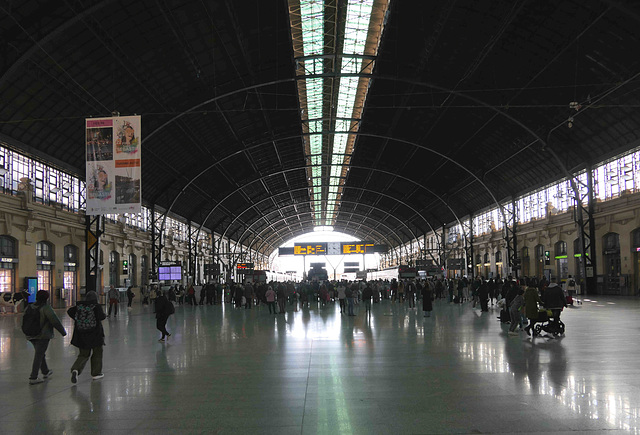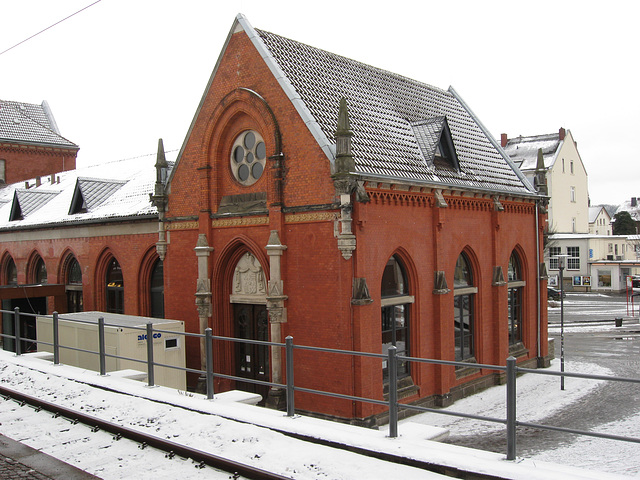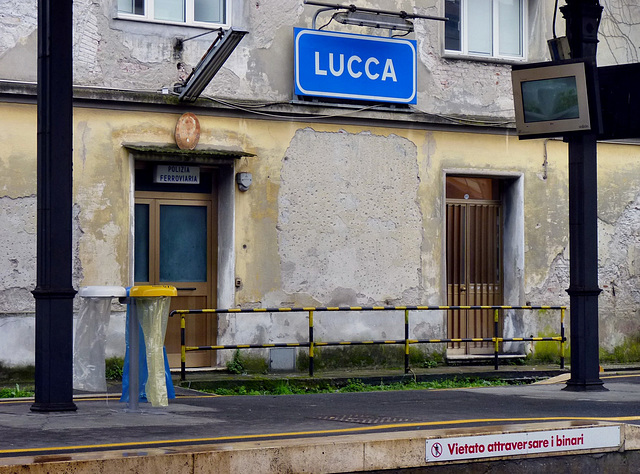
Stations
Valencia - Estacion del Norte
According to the Roman historian Titus Livius "Valentia" was founded by Consul Decimus Iunius Brutus Callaicus in the 4th century BC,
A century later "Valentia Edetanorum" became one of the first Hispanic cities to become a Roman colony.
The city made rapid progress after the Arab conquest in 711, reaching 15,000 inhabitants in the Caliphate of Córdoba. The Amirids and the Dhun Nunids ruled in “Balansiya”. In 1094, El Cid, a Castilian noble, conquered the city. The conquest was not carried out on behalf of one of the Christian kingdoms, but on the Cid's own account, who proclaimed himself "Señor de Valencia" and thus created a kind of private kingdom. He was able to defend the city against several Almoravid attacks, and after his death in 1099, his widow Jimena managed to hold Valencia until 1102, when it fell to the Almoravids, and a little later to the Almohads.
After the victory of the united Christian armies over the Almohads in the Battle of Las Navas de Tolosa (1212), Moorish Spain fell apart again into individual small kingdoms, including a Taifa from Valencia.
It was finally conquered in 1238 by Jaime I de Aragón (aka "el Conquistador"), after a five-month siege.
In the 15th century, the city grew rapidly and developed into one of the largest Mediterranean ports and an important trade and financial center. At the beginning of the 15th century the city had around 40,000.
The North Station is in the city center. The station was opened as a terminal station in 1917 after eleven years of construction. The building is one of the main works of Valencian Art Nouveau and was declared a heritage site in 1987.
Valencia - Estacion del Norte
According to the Roman historian Titus Livius "Valentia" was founded by Consul Decimus Iunius Brutus Callaicus in the 4th century BC,
A century later "Valentia Edetanorum" became one of the first Hispanic cities to become a Roman colony.
The city made rapid progress after the Arab conquest in 711, reaching 15,000 inhabitants in the Caliphate of Córdoba. The Amirids and the Dhun Nunids ruled in “Balansiya”. In 1094, El Cid, a Castilian noble, conquered the city. The conquest was not carried out on behalf of one of the Christian kingdoms, but on the Cid's own account, who proclaimed himself "Señor de Valencia" and thus created a kind of private kingdom. He was able to defend the city against several Almoravid attacks, and after his death in 1099, his widow Jimena managed to hold Valencia until 1102, when it fell to the Almoravids, and a little later to the Almohads.
After the victory of the united Christian armies over the Almohads in the Battle of Las Navas de Tolosa (1212), Moorish Spain fell apart again into individual small kingdoms, including a Taifa from Valencia.
It was finally conquered in 1238 by Jaime I de Aragón (aka "el Conquistador"), after a five-month siege.
In the 15th century, the city grew rapidly and developed into one of the largest Mediterranean ports and an important trade and financial center. At the beginning of the 15th century the city had around 40,000.
The North Station is in the city center. The station was opened as a terminal station in 1917 after eleven years of construction. The building is one of the main works of Valencian Art Nouveau and was declared a heritage site in 1987.
Canfranc Estación
"Canfranc International Railway Station" was opened in 1928, after a railway line, connecting France and Spain had been discussed since the 1850s, got finally completed. The line was opened, but never really sucessful. In 1970 a freight train derailed and destroyed a bridge on the French side of the Pyrenees. The bridge never got repaired - and the station is out of service ever since. Only two local trains leave this "palace", which is 240 meters long, every day.
The huge tunnel, that was drilled through the Pyrenees for the railway line, houses the "Laboratorio Subterráneo de Canfranc" meanwhile. Scientists there investigate neutrinos and WIMPS (= "Weakly interacting massive particles").
Urdos - Station
A railway line, connecting France and Spain was discussed already mid 19th century. After the construction of a tunnel, the line was opened in 1928, but was never really sucessful.
On a frosty morning in March 1970 a heavy freight train was approaching Urdos, when, due to a brake failure, the train derailed and destroyed the Pont de l‘Estanguet, 3kms south of Accous. The bridge never got rebuilt, the railway line was never used again - and the station is out of service ever since.
Cassagnas - The station
Back on the GR70. The old station of Cassagnas (now a CdH, gite, restaurant) reminds on the days of steam trains.
A perfectly restored station - without rails.
... followed the former railroad-track and passed the little station of "Bretagne d` Armagnac", the owners had restored so perfectly, that it looked like a 1:1 model of a small railway station. Just that there were no rails next to the little platform. Maybe the owners sat inside wearing the old railway-uniforms and drinking coffee.....
Detmold
This part of the station (seen from the platform) seems to be a neogothic chapel. Here were the waiting rooms for the nobility in the 19th century. See the coat of arms over the door.
Chilly-Mazarin - Station
A ride from here into the center of Paris (Metro "St-Michel/Notre Dame") takes about 40 minutes.
Lucca - Station
It had started to rain, when I left Pisa. The rain poured down, when I arrived in Lucca, 20km northeast. For the next 10 days, the rain did not stop. Maybe early March is not the best time to travel in Tuscany.
Jump to top
RSS feed- Latest items - Subscribe to the latest items added to this album
- ipernity © 2007-2025
- Help & Contact
|
Club news
|
About ipernity
|
History |
ipernity Club & Prices |
Guide of good conduct
Donate | Group guidelines | Privacy policy | Terms of use | Statutes | In memoria -
Facebook
X










